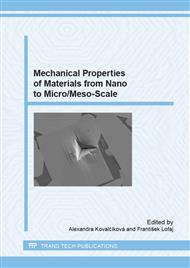p.11
p.15
p.19
p.23
p.27
p.31
p.35
p.39
p.43
Relationship between Indenter Calibration and Measured Mechanical Properties of Elastic-Plastic Materials
Abstract:
Calibration of Berkovich indenter area function was performed on materials with different elastic-plastic behavior resulting in pile-up and sink-in, respectively. Experimentally obtained results were compared with the results obtained by the application of theoretical area function. The values of Young’s modulus and hardness were significantly affected by the calibration function used. Since the effects of pile-up and sink-in are already included in the used area function, this simple method can lead to more accurate results of Young’s modulus and hardness measurements.
Info:
Periodical:
Pages:
27-30
Citation:
Online since:
September 2015
Authors:
Price:
Сopyright:
© 2015 Trans Tech Publications Ltd. All Rights Reserved
Share:
Citation:


